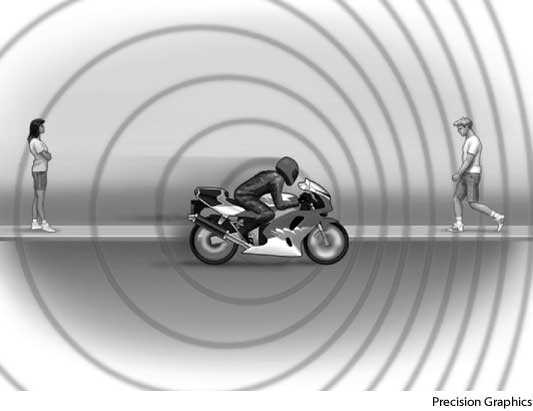The Doppler Effect is a well-known scientific principle to most people. To use a common example, it is demonstrated when an ambulance or some other vehicle with an activated siren passes you. As the vehicle moves towards you, its sound waves come at you in a manner where they are closer together, whereas when it travels away, the sound waves are stretched because their source emits the waves at a farther and farther distance away. Basically the relative motion of the emitter changes the apparent frequency of the sound waves, so an object getting closer appears to increase in frequency, reaches its peak when closest to you, and decreases in frequency when moving away. This concept is illustrated below:
The sound of the motorbike decreases as it moves away from the woman and increases as it moves towards the man
The same principle is applicable for light. Light emitted from an object moving towards you increases in frequency, resulting in it being shifted to the blue end of the visible spectrum. The light emitted from an object moving away decreases in frequency, so the light is shifted towards the red end of the spectrum. This shift is largely imperceptible in everyday objects, but measurable for things moving very fast. Hubble applied this experiment to the newly discovered galaxies. When Hubble measured the light from these galaxies, he found that nearly all were red-shifted. This meant that galaxies were moving away from us, but not only moving away, but the farther they were away, the faster their rate of retreat. This lead to the conclusion that either our galaxy was somehow the center of a universal retreat from galaxies, or far more likely, the space itself between galaxies was expanding. Hubble measured this rate of expansion, now called Hubble's Constant.
The Doppler Effect when applied to light
So space was expanding. But not only was it expanding, its rate of expansion was increasing. This would lead science to a whole new understanding of our universe, an understanding that would culminate in nothing less than the very birth of our cosmos. So, next post will be about a big topic: the big bang theory. Feel free to ask questions and subscribe! Until then, salutations!


I have a question. I know that, like sound, the closer you are to the source, the higher piched the sound is. But for light, you have to measue the redshift, right? So do the scientists send out X-rays to meausue the redshift?
ReplyDeleteWell, the pitch doesn't change with distance, simply the volume. The pitch is only changed by relative motion. As for how redshift is measured, elements that are heated give off light, and when this light is separated in a prism, it forms characteristic bands of black, every elements' emissions are the same pattern. To measure redshift, we take these emissions and separate them and find if they're near the red end of the spectrum or blue end. The emissions of galaxies are nearly all towards the red side
ReplyDeleteI also have another question. Why are the sound molocules closer to each other when you're closer to the sound?
ReplyDeleteWell, sound isn't perpetuated by molecules, it comes out in waves.
ReplyDeleteSo as the object moves it emits a wave and as it moves again another wave and the closer it gets, the closer the waves are getting together. Look at the diagram if this confuses you
ReplyDelete